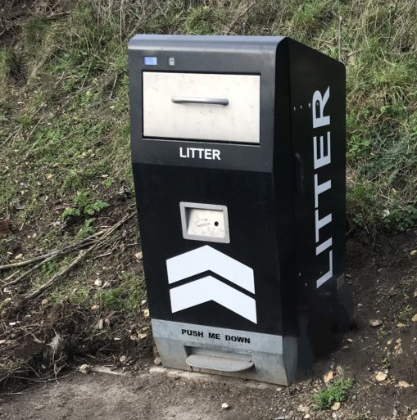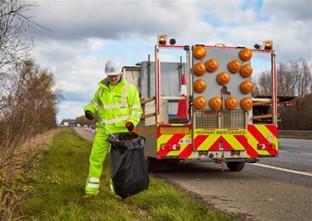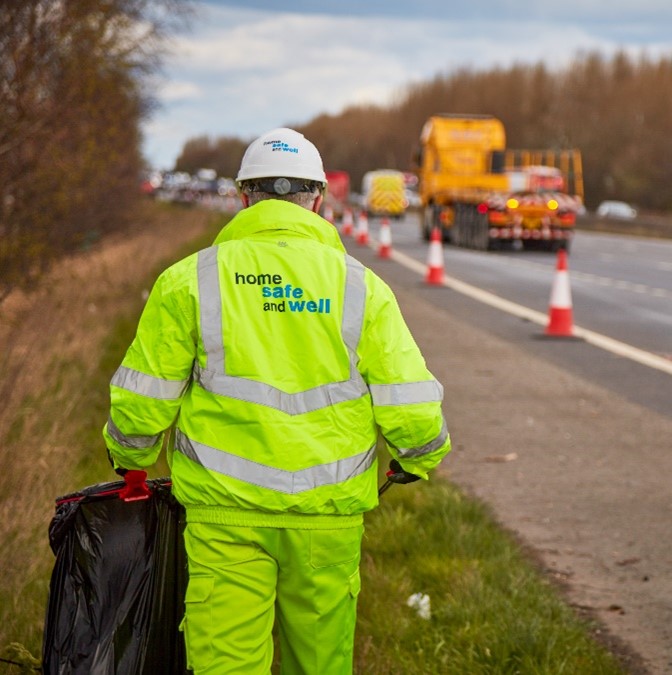Litter on motorways and major A roads
Litter puts road users and the people who have to pick it up at risk. It also threatens wildlife living alongside our roads. Dealing with litter takes valuable resources away from other work.
Roads we clear litter from
Under the Environmental Protection Act 1990, we're responsible for clearing litter on:
- England’s motorways
- a small number of major A roads (also known as all-purpose trunk roads)
You can see the full list of roads we’re responsible for in our Litter approach (PDF).
Our approach to litter
Our Litter approach describes how we reduce litter on our network and deliver an effective litter clearing service.
We aim to do this by:
- influencing littering behaviour
- improving our operational delivery and asset maintenance
- seeking and responding to customer feedback
- improving partnership working
Learn more about our approach by reading our Litter approach (PDF).
How we influence littering behaviour
We need to do more to combat litter by changing the behaviour of people who feel it's all right to drop it.
To better understand littering and ways we can influence behaviour, we commission research such as this Vehicle Littering Research Report.
We influence littering behaviour through education by running communication campaigns and supporting our partners to persuade road users and the wider public to take responsibility for their own litter.

We adapt our messaging for different road users and different littering behaviour based on customer insight data.
We display messages to educate the public about the impact of littering, but also to communicate the greater chance of being caught littering and the fixed penalties for doing so.
Our anti-littering measures
We also try to influence littering behaviour through anti-littering measures.
Bin infrastructure
We install drive-up window-height bins, so users can get rid of litter without leaving their vehicle, and compacting bins that maximise availability and capacity, while also reducing the number of times they need to be emptied.

Anti-littering signage
Our anti-littering signage is based on customer feedback and is deployed in specific areas such as litter hotspots to maximise impact.
Innovative technology
We use technology designed to deter people from littering.
Litter picking
We plan litter picking activity carefully, as with all our maintenance work. We aim to combine litter picking with other routine activities to:
- improve operational delivery and mainten ance
- keep our workers safe
- minimise disruption to road users
- manage costs
We plan our litter picks via three programmes:.
Cyclical maintenance
Cyclical maintenance is our yearly cycle of works. We aim to clear every location of litter at least once per year - these activities are planned and roads inspected in accordance with:
- The Department for Environment, Food and Rural Affairs’ Code of practice for litter and refuse
- GM701 Highways Asset delivery & maintenance requirements
- GS801 Highway Asset delivery & asset inspection requirements
Litter hotspot maintenance
Litter hotspots are identified as the most problematic areas in terms of repeat littering. We clear them monthly, quarterly or every six months.

Reactive maintenance
This is carried out when an immediate response is required. Where litter or debris is a hazard to road users (such as tyre debris in live lanes), we'll use emergency measures to prioritise its removal.
Operational delivery and asset maintenance
We aim to improve our operational delivery by compiling and using data via our CONFIRM systems. We register and log all litter picks, including information on exact location and amount of litter picked. We use this data to create more informed and effective plans and identify problem areas.
We review changes in local infrastructure, such as the opening of new fast-food chains or waste recycle centres, to evaluate the impact and understand how we can manage it.
We use customer feedback to understand our current performance and improve our operations.

Why we seek and respond to customer feedback
We gather customer feedback to identify areas for improvement and develop strategies to enhance our performance.
We gather feedback about litter through:
- monthly customer satisfaction surveys - conducted at national and regional level
- customer comments via phone, mail and our social media channels
- conducting extensive research to understand customer attitudes to all aspects of our service and performance, including litter
- Transport Focus - this is an independent watchdog representing the interest of road users
We use this feedback to check whether our work is noticed by customers and whether it meets their expectations.
Partnership working
We believe that littering is a societal problem, and through partnership working we can have a bigger impact in addressing it.
We work with various bodies and anti-litter organisations, including Keep Britain Tidy, to tackle litter and make it socially unacceptable.
We'll continue working with local authorities to co-ordinate litter picking with routine maintenance work to minimise disruption to road users.
We share knowledge and best practice with organisations like Keep Britain Tidy and motorway service operators, and work with them on joint initiatives and information campaigns such as Keep Britain Tidy’s annual Great British Spring Clean campaign. We picked over 6,000 bags of litter as part of this initiative in 2024.
We’re aiming to extend our collaborative working arrangements, developing agreements with key stakeholders, including local authorities and the freight and road haulage industry, to help reduce the need for litter picking on our network.
